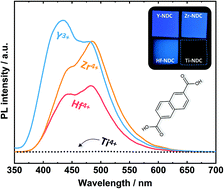Molecular layer deposition of photoactive metal-naphthalene hybrid thin films†
Abstract
We here report on photoactive organic–inorganic hybrid thin films prepared by the molecular layer deposition (MLD) method. The new series of hybrid films deposited using 2,6-naphthalenedicarboxylic acid (2,6-NDC) and either hafnium chloride (HfCl4), yttrium tetramethylheptanedionate (Y(thd)3) or titanium chloride (TiCl4) were compared with the known zirconium chloride (ZrCl4) based system. All metal-naphthalene films are amorphous as-deposited and show self-saturating growth as expected for an ideal MLD process with varied growth rates depending on the choice of metal precursor. The growth was studied in situ using quartz crystal microbalance (QCM) and the films were further characterised using spectroscopic ellipsometry (SE), Fourier transform infrared spectroscopy (FTIR), X-ray photoelectron spectroscopy (XPS), and UV-Vis and photoluminescence (PL) spectroscopy to obtain information on their physicochemical properties. The hybrid thin films display intense blue photoluminescence, except for the Ti-organic complex in which titanium clusters were found to be an effective PL quencher for the organic linker. We demonstrate how the optical properties of the films depend on the choice of metal component to make a foundation for further studies on these types of organic–inorganic hybrid materials for applications as photoactive agents.



 Please wait while we load your content...
Please wait while we load your content...